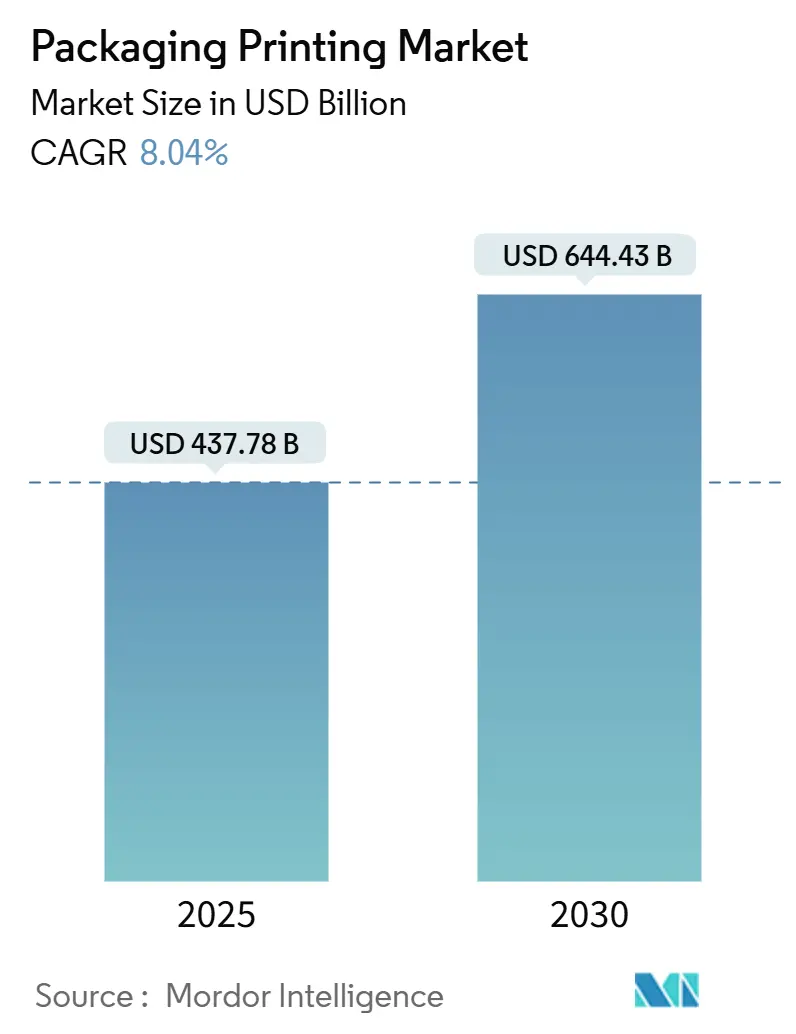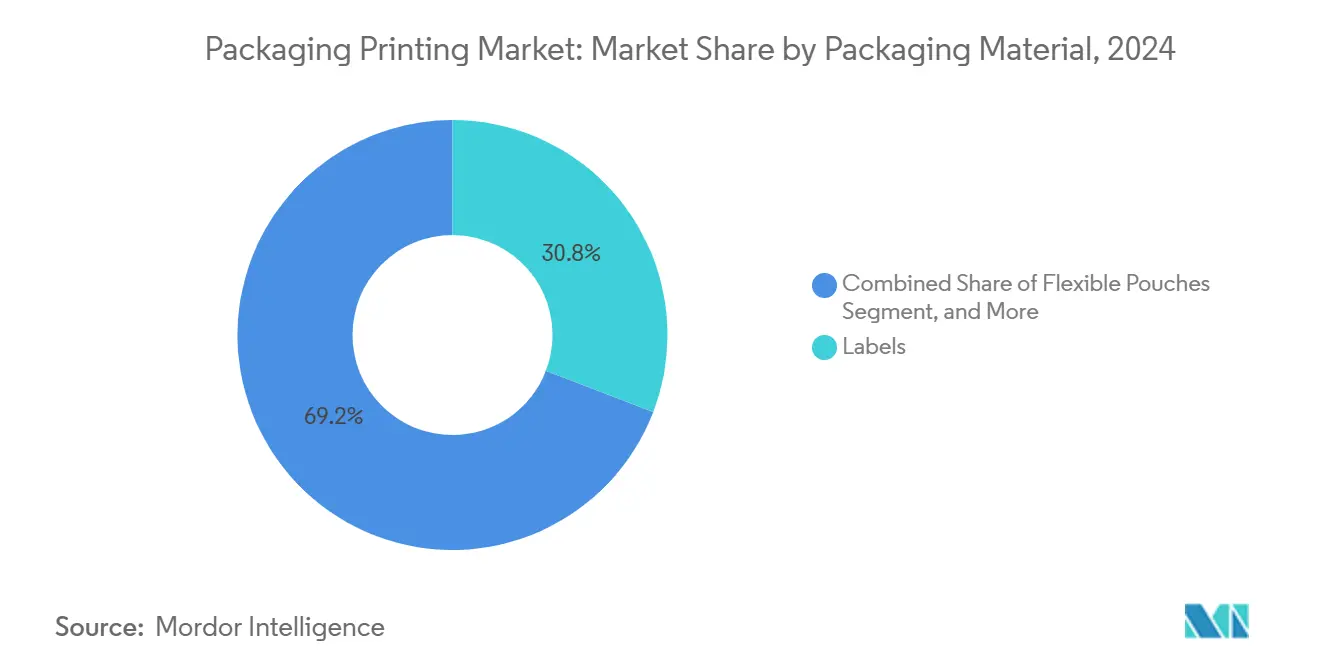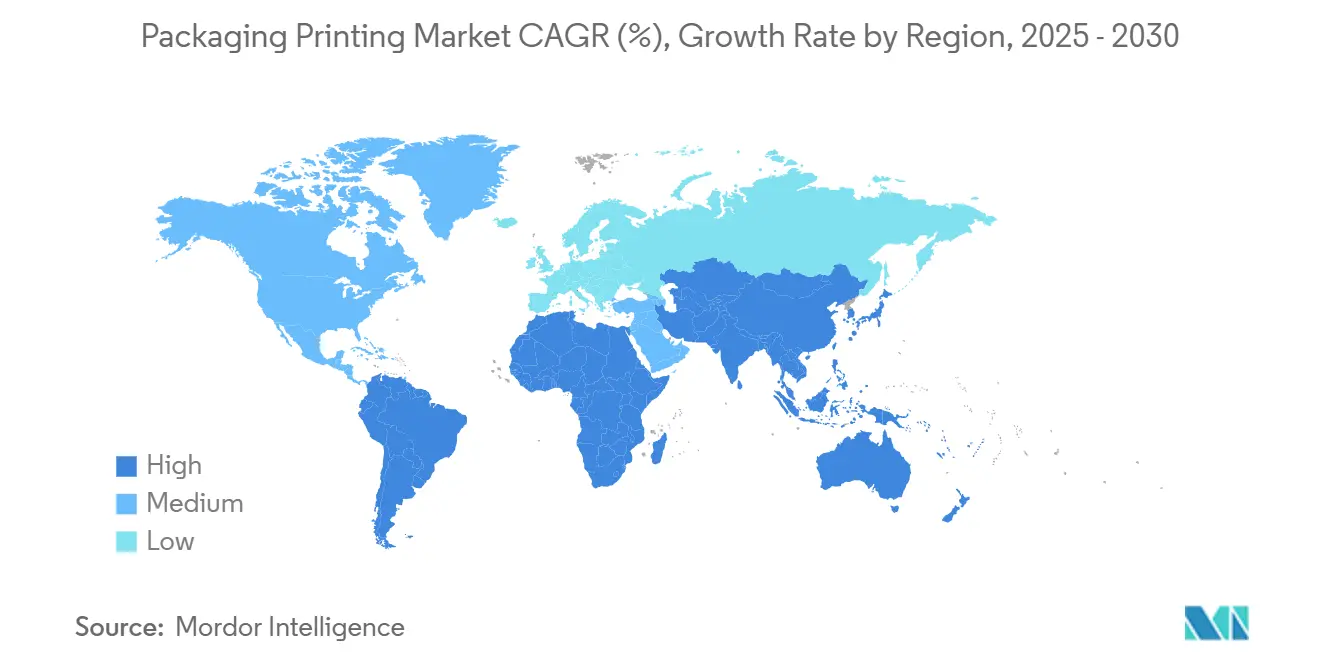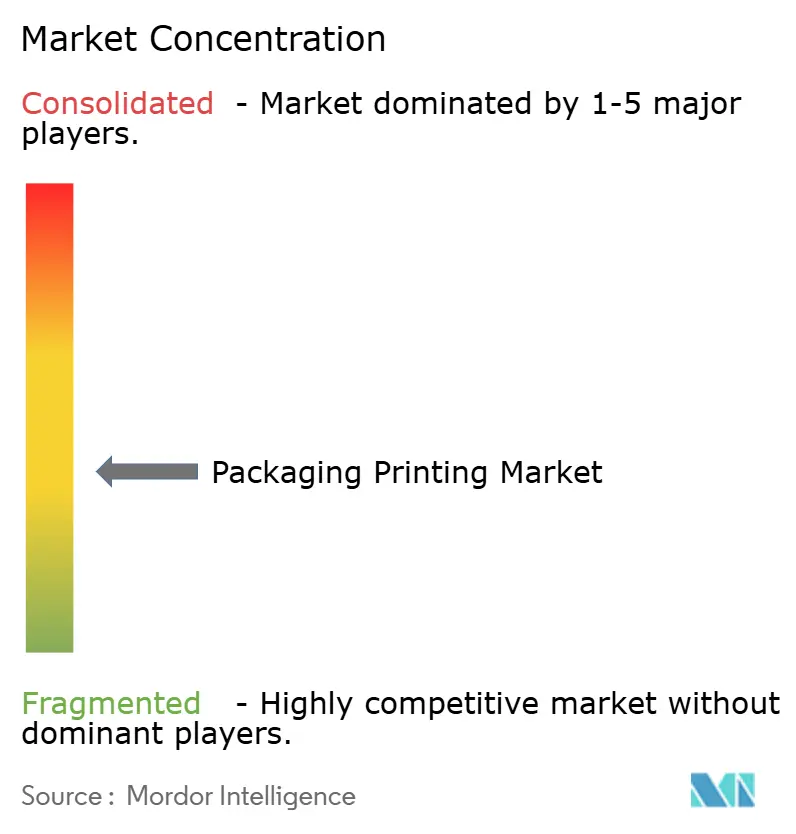Packaging Printing Market Size and Share

Packaging Printing Market Analysis by Mordor Intelligence
The packaging printing market size was USD 437.78 billion in 2025 and is expected to reach USD 644.43 billion by 2030, reflecting an 8.04% CAGR. Rapid digital transformation, soaring e-commerce activity, and stringent sustainability policies are reshaping technology selection, substrate choice, and regional investment priorities. Flexography keeps its volume edge thanks to productivity on long runs, yet brand owners now favor digital platforms for short batches that support SKU proliferation, variable data, and smart-pack functionality. UV-curable ink chemistry gains ground as converters look for lower energy use and faster throughput, while RFID-enabled packs strengthen supply-chain visibility. At a strategic level, converters combine hybrid press lines, localized micro-factories, and closed-loop material programs to defend margins in a market where brand loyalty depends on print quality, speed, and environmental footprint.
Key Report Takeaways
- By printing technology, flexography captured 35.32% of the packaging printing market share in 2024, digital printing is projected to expand at a 10.32% CAGR through 2030 within the packaging printing market size.
- By ink type, solvent-based inks accounted for 40.01% share of the packaging printing market size in 2024, UV-curable inks are advancing at a 9.65% CAGR across the packaging printing market size to 2030.
- By packaging material, labels retained 30.83% of the packaging printing market share in 2024, while flexible pouches are moving at a 9.34% CAGR to 2030.
- By end-use industry, food and beverage held 28.34% share of the packaging printing market size in 2024; cosmetics and personal care is rising at a 9.88% CAGR through 2030.
- By geography, Asia-Pacific leads with 34.00% of print equipment market share in 2024, and the region is projected to rise at a 6.3 % CAGR up to 2030.
Global Packaging Printing Market Trends and Insights
Drivers Impact Analysis
| Driver | (~) % Impact on CAGR Forecast | Geographic Relevance | Impact Timeline |
|---|---|---|---|
| Demand for RFID-enabled and digital printing | +1.8% | Global, with early adoption in North America and EU | Medium term (2-4 years) |
| Expansion of e-commerce packaging volumes | +2.1% | Global, strongest in APAC and North America | Short term (≤ 2 years) |
| Sustainability push for eco-friendly inks and substrates | +1.5% | EU and North America leading, spreading to APAC | Long term (≥ 4 years) |
| Emerging-market consumption boom | +1.7% | APAC core, spill-over to MEA and Latin America | Medium term (2-4 years) |
| Brand-owner adoption of smart pack serialization | +1.2% | Global, with pharmaceutical focus in regulated markets | Medium term (2-4 years) |
| Rise of localized print-on-demand micro-factories | +0.9% | Urban centers globally, concentrated in APAC | Long term (≥ 4 years) |
| Source: Mordor Intelligence | |||
Demand for RFID-enabled and Digital Printing
Widespread IoT connectivity is turning each package into a data node, and pressure-sensitive labels embedded with RFID are now common on high-value pharmaceuticals. Digital presses integrate serialized codes without plate changes, cutting unit costs and enabling real-time authentication. Consumer-facing apps read these identifiers to reveal provenance or loyalty offers, deepening engagement while assisting recall management. Converters that combine flexo efficiency with inline inkjet modules meet traceability mandates and win contracts that reward responsiveness.
Expansion of E-commerce Packaging Volumes
Direct-to-consumer logistics prioritize lightweight formats that protect goods, showcase graphics, and arrive swiftly. Print-on-demand networks such as Gelato’s cut shipping distance by 90%, proving localized production scales once digital workflows replace analog set-up. Shorter run lengths – often below 10,000 units – push traditional offset out of contention, encouraging investment in high-speed inkjet and toner machines that deliver shelf-ready quality overnight. The packaging printing market benefits as every unboxing video becomes free advertising, pushing brands to refresh artwork more often.
Sustainability Push for Eco-friendly Inks and Substrates
Europe’s Single-Use Plastics Directive bans difficult-to-recycle packs, steering converters toward mono-material films, water-based ink systems, and UV-LED curing that slashes energy by 70% . Huhtamaki’s blueloop line illustrates the pay-off: recyclable barrier pouches that keep food safe yet meet circular-economy criteria. Suppliers respond with photoinitiators free of hazardous substances and de-inking-friendly pigments, while buyers write sustainability KPIs into RFQs, turning compliance into a prerequisite for tender participation.
Emerging-Market Consumption Boom
Rising disposable income across China, India, and Indonesia fuels demand for packaged snacks, beverages, and cosmetics that rely on vivid graphics and multilingual copy. Multinationals deploy micro-factories near megacities to sidestep import duties and tailor artwork to regional holidays. Flexible formats dominate thanks to cost and convenience, lifting ink volumes and press installations. As the middle class associates branding with quality, converters that hit color targets consistently gain repeat volumes, cementing long-term supply agreements.
Restraints Impact Analysis
| Restraint | (~) % Impact on CAGR Forecast | Geographic Relevance | Impact Timeline |
|---|---|---|---|
| High capital investment requirements | -1.4% | Global, particularly affecting SMEs in developing markets | Short term (≤ 2 years) |
| Complex and varying global printing regulations | -0.9% | Global, with highest impact in EU and North America | Medium term (2-4 years) |
| Volatile photoinitiator and resin prices | -1.1% | Global, with supply chain concentration in Asia | Short term (≤ 2 years) |
| Shortage of skilled flexographic press operators | -0.8% | Developed markets, particularly North America and Europe | Long term (≥ 4 years) |
| Source: Mordor Intelligence | |||
High Capital Investment Requirements
A high-speed eight-color flexo line costs up to USD 2.94 million and demands auxiliary slitters, plate mounters, and solvent-recovery units. Smaller converters in Southeast Asia delay upgrades, risking obsolescence as brand owners insist on tighter tolerances. Leasing programs exist, but interest rates elevate the total cost of ownership. Consolidation, therefore, accelerates deep-pocketed groups buying family-run shops to unlock scale and negotiate better substrate contracts.
Complex and Varying Global Printing Regulations
Converters selling into both the FDA and REACH jurisdictions juggle separate positive lists for ink components.[1] European Commission, “Single-Use Plastics Directive,” ec.europa.eu Documentation, migration testing, and change-control audits absorb up to 5% of annual revenue, according to corporate filings. Medium-sized firms dedicate cross-functional teams to track amendments, and some exit export markets rather than retrofit assets or duplicate inventory. Harmonization talks are ongoing, yet near-term relief is unlikely, preserving compliance as a barrier to entry.
Segment Analysis
By Printing Technology: Digital Innovation Accelerates Traditional Dominance
Flexography held a 35.32% share of the packaging printing market size in 2024, supported by unrivaled speed on film and paper webs. Hybrid press platforms now layer inkjet stations onto flexo units, enabling serial codes and regional graphics without slowing the run. Digital equipment records a 10.32% CAGR through 2030 as converters chase shorter cycles and SKU proliferation. Rotogravure retains a niche status in premium tobacco and cosmetics, where image fidelity justifies cylinder engraving costs. Offset lithography concentrates on folding cartons, while screen printing and other niche methods address tactile varnishes and metallic effects.
Investment data confirms the trajectory. Pack lines installed in 2025 feature predictive-maintenance sensors that cut unplanned downtime by 18%, and cloud-based color servers align artwork across plants in real time. Converters adopting the hybrid model report making ready waste down by 28% and TTM (time to market) halved for promotional packs. As such, equipment suppliers bundle workflow software with presses, locking in service revenue and strengthening aftermarket margins within the packaging printing market.

Note: Segment shares of all individual segments available upon report purchase
By Ink Type: UV Technology Challenges Solvent Dominance
Solvent systems maintained a 40.01% share of the packaging printing market size in 2024. Yet UV-curable ink volumes rise at 9.65% CAGR as LED lamps curb power draw to 0.3-0.5 kWh per square meter versus 1.2-1.8 kWh for thermal ovens.[2]StarColor Ink, “Gravure vs Digital Printing Cost Comparison,” starcolor-ink.com Aqueous formulations grow fastest in paper-heavy segments where food contact regulations restrict VOCs. Latex and LED-UV chemistries address shrink labels and heat-sensitive films once off-limits to mercury-lamp curing.
Total-cost models favor UV in high-mix environments: plate washout stations disappear, inventory of solvents shrinks, and cure-on-demand lowers WIP. Resin volatility remains a risk, but multi-sourcing and in-house blending partly offset spikes. Ink suppliers invest in bio-based monomers and photoinitiators that pass compostability tests, aligning chemistry advances with the sustainability agenda permeating the packaging printing market.
By Packaging Material: Flexible Solutions Drive Innovation
Labels commanded 30.83% of the packaging printing market share in 2024, indispensable for UPCs and regulatory copy. Flexible pouches lead growth at 9.34% CAGR thanks to portability, reclose functions, and reduced shipping weight. Corrugated shippers for e-commerce adopt high-definition post-print to convert every parcel into a billboard. Cartons retain presence in cereals and pharmaceuticals where shelf stiffness is critical.
Pouches also integrate barrier coatings that block oxygen yet permit recycling in established polyolefin streams. Smurfit Kappa’s substitution of a pet food tub with a corrugated insert cut plastic by 25 tonnes and logistics cost by 40%, proving print quality can coexist with sustainability goals.[3]Huhtamaki, “blueloop Sustainable Innovation,” huhtamaki.com Inks must therefore resist retort temperatures or HPP cycles while preserving vibrant hues, pushing R&D budgets upward across the packaging printing market.

Note: Segment shares of all individual segments available upon report purchase
By End-Use Industry: Cosmetics Momentum Challenges Food Dominance
Food and beverage accounted for 28.34% of the packaging printing market size in 2024, driven by safety labeling and promotional cycles. Cosmetics and personal care logs the quickest climb at 9.88% CAGR, propelled by social-media aesthetics and demand for authenticity codes. The pharmaceutical segment invests heavily in micro-text, Braille, and tamper-evident seals as DSCSA enforcement tightens. Household chemicals emphasize durability against caustic contents, while electronics packaging focuses on ESD-safe inks and compliant pictograms.
Influencer culture means a lipstick launch may require a 100-unit run in five languages, something only digital presses can profitably execute. Luxury brands embed metallic foils and raised varnish for tactile impact, operations traditionally costly but now streamlined with single-pass inkjet units. As wellness spending rises in emerging markets, converters that demonstrate GMP audits and cleanroom capability secure high-margin contracts within the packaging printing market.
Geography Analysis
Asia-Pacific leads global output, housing more than half of new press installations in 2024. China’s converters add multi-layer pouch lines to feed domestic snack demand, while India offers incentives for capital purchases under its Production-Linked Incentive scheme. Flexible packaging makers in Vietnam and Thailand gain from near-shoring, serving apparel exporters that need rapid swing tags and polybags. Cross-border investments elevate regional know-how, and joint ventures with Japanese ink suppliers improve quality consistency.
North American operators' position on technology and compliance. Investments in digital corrugated presses triple capacity for same-day e-commerce boxes, and state legislatures adopt extended producer responsibility fees that reward recyclable prints. U.S. converters also pioneer UV-LED retrofits, claiming 25% energy savings. Canada harmonizes food-contact limits with the FDA, easing cross-border sourcing, while Mexico attracts Tier-1 brands searching for tariff-free access under USMCA.the
Europe sets the regulatory tempo. The bloc’s 88% packaging recycling target nudges brand guidelines toward mono-material laminates that rely on specialized inks. German machinery exports leverage Industrie 4.0 features such as real-time viscosity control, and Italian press builders bundle in-line cold-foil to court luxury houses. Eastern Europe, notably Poland, captures overflow work as labor rates undercut Western peers, yet workforce skills remain high. Innovation grants in the Netherlands fund pilot lines for paper-based barrier packs, sustaining momentum in the packaging printing market.

Competitive Landscape
The market is moderately fragmented. Top global converters Amcor, Smurfit Kappa, WestRock, Tetra Pak, and TC Transcontinental combine for roughly 35% of worldwide revenue, while thousands of regional specialists serve niche or local demand. Multinationals pursue vertical integration, buying ink formulators or pre-press houses to secure supply and unlock margin. Digital disruptors such as ePac Flexible Packaging deploy identical HP Indigo fleets across 24 micro-sites, offering 10-day lead times that threaten incumbents on agility.
Strategic moves concentrate on sustainability. Amcor commits USD 200 million to boost recycled content across its printing operations, and BOBST licenses oneBARRIER recyclable mono-material technology to partners worldwide. In M&A, converters target boutique sleeve printers and label plants to obtain cosmetic and nutraceutical accounts. Automation also marks competitive differentiation: AI-driven defect inspection cuts waste to 1.5% for leading plants, compared with 3-4% at laggards. Such investments, while capital-intensive, secure preferred-supplier status with global brand owners and reinforce pricing power inside the packaging printing market.
Packaging Printing Industry Leaders
-
Mondi PLC
-
Avery Dennison Corporation
-
CCL Industries Inc.
-
Smurfit WestRock
-
Sealed Air Corporation
- *Disclaimer: Major Players sorted in no particular order

Recent Industry Developments
- March 2025: Huhtamaki published its 2024 Annual Report detailing EUR 4.1 billion (USD 4.37 billion) net sales and European Sustainability Reporting Standards compliance.
- February 2025: Huhtamaki announced it will split its Fiber Foodservice Europe-Asia-Oceania business into two units – Fiber Packaging and Foodservice Europe-Asia-Oceania – effective 1 Apr 2025.
- January 2025: Smurfit Kappa completed a sustainability-focused redesign for German pet-food brand Mera, replacing plastic tubs with corrugated boxes and cutting annual plastic by 25 tonnes.
- January 2025: Industrial Packaging installed a 350-TC flow wrapper at Garuka Bars, lowering pack cost from USD 0.10 to USD 0.01 and quadrupling throughput.
Global Packaging Printing Market Report Scope
Packaging printing encompasses various methods, including rotogravure and flexography, distinct from publication printing. It involves printing on paper, board, metal foil, and plastic film, which are then processed into packaging products and labels. This category includes cartons, folding boxes, flexible packaging, labels, and wrapping materials. The packaging printing industry is closely related to consumer goods, food and beverage, pharmaceuticals, and other sectors that require attractive and informative packaging.
The packaging printing market is segmented by printing technology (offset lithography, rotogravure, flexography, digital printing, and screen printing), ink type (solvent-based ink, UV-curable ink, and aqueous ink), packaging type (label, plastic, glass, metal, and paper and paperboard), application (cosmetic and homecare, food and beverage, pharmaceutical, and applications), and geography (North America [United States and Canada], Europe [Germany, France, United Kingdom, and Rest of Europe], Asia [China, India, Japan, Australia, and New Zealand, Rest of Asia], Latin America [Brazil, Mexico, and Columbia], Middle East and Africa [United Arab Emirates, Saudi Arabia, and South Africa]). The market sizes and forecasts are provided regarding value (USD) for all the above segments.
| Offset Lithography |
| Rotogravure |
| Flexography |
| Digital Printing |
| Other Printing Technologies |
| Solvent-based Ink |
| UV-curable Ink |
| Aqueous Ink |
| Latex Ink |
| LED-UV Ink |
| Labels |
| Plastic Containers and Films |
| Glass Containers |
| Metal Cans and Foils |
| Paper and Paperboard Cartons |
| Flexible Pouches |
| Corrugated Boxes and Trays |
| Food and Beverage |
| Pharmaceutical and Healthcare |
| Cosmetics and Personal Care |
| Household and Industrial |
| Electronics and Electrical |
| Other End-Use Industries |
| North America | United States | |
| Canada | ||
| Mexico | ||
| South America | Brazil | |
| Argentina | ||
| Chile | ||
| Rest of South America | ||
| Europe | United Kingdom | |
| Germany | ||
| France | ||
| Spain | ||
| Italy | ||
| Rest of Europe | ||
| Asia-Pacific | China | |
| India | ||
| Japan | ||
| Australia | ||
| South Korea | ||
| Vietnam | ||
| Rest of Asia-Pacific | ||
| Middle East and Africa | Middle East | Saudi Arabia |
| United Arab Emirates | ||
| Turkey | ||
| Rest of Middle East | ||
| Africa | South Africa | |
| Nigeria | ||
| Egypt | ||
| Rest of Africa | ||
| By Printing Technology | Offset Lithography | ||
| Rotogravure | |||
| Flexography | |||
| Digital Printing | |||
| Other Printing Technologies | |||
| By Ink Type | Solvent-based Ink | ||
| UV-curable Ink | |||
| Aqueous Ink | |||
| Latex Ink | |||
| LED-UV Ink | |||
| By Packaging Material | Labels | ||
| Plastic Containers and Films | |||
| Glass Containers | |||
| Metal Cans and Foils | |||
| Paper and Paperboard Cartons | |||
| Flexible Pouches | |||
| Corrugated Boxes and Trays | |||
| By End-Use Industry | Food and Beverage | ||
| Pharmaceutical and Healthcare | |||
| Cosmetics and Personal Care | |||
| Household and Industrial | |||
| Electronics and Electrical | |||
| Other End-Use Industries | |||
| By Geography | North America | United States | |
| Canada | |||
| Mexico | |||
| South America | Brazil | ||
| Argentina | |||
| Chile | |||
| Rest of South America | |||
| Europe | United Kingdom | ||
| Germany | |||
| France | |||
| Spain | |||
| Italy | |||
| Rest of Europe | |||
| Asia-Pacific | China | ||
| India | |||
| Japan | |||
| Australia | |||
| South Korea | |||
| Vietnam | |||
| Rest of Asia-Pacific | |||
| Middle East and Africa | Middle East | Saudi Arabia | |
| United Arab Emirates | |||
| Turkey | |||
| Rest of Middle East | |||
| Africa | South Africa | ||
| Nigeria | |||
| Egypt | |||
| Rest of Africa | |||
Key Questions Answered in the Report
What is the current value of the global packaging printing market?
The packaging printing market size stands at USD 437.78 billion in 2025.
How fast is digital printing growing within packaging applications?
Digital technologies are advancing at a 10.32% CAGR through 2030, the fastest rate among all print methods.
Which ink system is gaining the most share from solvent-based formulations?
UV-curable inks, powered by LED drying, are increasing at a 9.65% CAGR due to energy and sustainability advantages.
Why are flexible pouches expanding more quickly than rigid formats?
Consumers favor reclose features and lightweight convenience, pushing flexible pouches to a 9.34% CAGR.
How do sustainability regulations influence material selection?
EU and North American rules mandate recyclable or mono-material structures, propelling demand for eco-friendly inks and substrates.
Which region leads the world in packaging printing volume?
Asia-Pacific holds the production lead, driven by China and India’s large consumer bases and expanding manufacturing hubs.
Page last updated on:
.webp)


